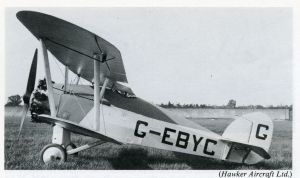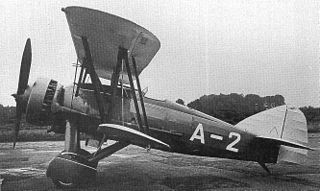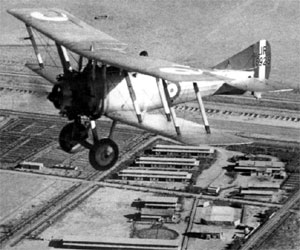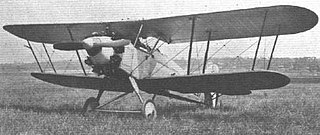
The Fairey Seafox was a 1930s British reconnaissance floatplane designed and built by Fairey for the Fleet Air Arm. It was designed to be catapulted from the deck of a light cruiser and served in the Second World War. Sixty-six were built, with two finished without floats and used as landplanes.

The Hawker Duiker was an unusual and unsuccessful aircraft. It was the first design at Hawker under a new chief designer, Captain Thomson, in 1922. Much of the equipment and parts were proprietary and made by another aircraft company, Vickers, which shared the airfield at Brooklands with Hawker. The Duiker was a parasol wing monoplane in a period where the biplane held sway.

The Hawker Woodcock was a British single-seat fighter built by the Hawker Engineering Company as the first fighter to be produced by Hawker Engineering. It was used by the RAF as a night fighter in the 1920s.

Fokker D.XVII, was a 1930s Dutch sesquiplane developed by Fokker. It was the last fabric-covered biplane fighter they developed in a lineage that extended back to the First World War Fokker D.VII.

The Armstrong Siddeley Jaguar is an aircraft engine developed by Armstrong Siddeley. The Jaguar was a petrol-fuelled air-cooled 14-cylinder two-row radial engine design. The Jaguar III was first used in 1923, followed in 1925 by the Jaguar IV and in 1927 by the Jaguar VI. In 1925 the Jaguar became the first production aero engine incorporating a geared supercharger.

The Hawker Horsley was a British single-engined biplane bomber of the 1920s. It was the last all-wooden aircraft built by Hawker Aircraft, and served as a medium day bomber and torpedo bomber with Britain's Royal Air Force between 1926 and 1935, as well as the navies of Greece and Denmark.

The Hawker Heron was the first fighter aircraft designed at Hawker Aircraft with a basically metal structure. Sydney Camm was the chief designer that introduced what became the typical structure for all Hawker aircraft until the introduction of the jet-powered Hawker P.1040. This structure consisted of metal tubes with their ends swaged so that they could be connected to each other by means of "fishplates" and bolts.
The Fairey P.4/34 was a competitor for an order for a light bomber to serve with the Royal Air Force. Although not produced in that form, it formed the basis for the Fulmar long-range carrier-based fighter for the Fleet Air Arm.

The Hawker Dantorp H.B. III was a Danish single-engined biplane bomber of the 1930s. The aircraft was a development of the British Hawker Horsley designed for the Danish Navy, but differed in being powered by a radial engine and having a third crew member. Two examples were built in Britain as a precursor to license production in Denmark. Financial constraints meant this was not realised and the Hawker-built examples were the only aircraft produced. They served until the German invasion of Denmark in 1940.

The Armstrong Whitworth A.W.16 was a British single-engine biplane fighter aircraft designed and built by Armstrong Whitworth Aircraft. A number were sold to the Chinese Kwangsi Air Force.

The Avia BH-28 was a military reconnaissance biplane aircraft developed in Czechoslovakia in 1927 to meet a requirement for such an aircraft by the government of Romania. Avia based the design on their BH-26, but replaced the engine with an Armstrong Siddeley Jaguar, as specified in the requirement. The completed aircraft was taken to Bucharest for demonstration, but no order ensued, and this prototype was the only example constructed.

The Gloster SS.35 Gnatsnapper was a British naval biplane fighter design of the late 1920s. Two prototypes were built but the type did not enter production.

The Parnall Plover was a British single-seat naval fighter aircraft of the 1920s. Designed and built by George Parnall & Co. for use on Royal Navy aircraft carriers, it was ordered into small-scale production but after extensive evaluation, the Fairey Flycatcher was preferred for large-scale service.

The Koolhoven F.K.51 was a 1930s Dutch two-seat basic training biplane built by the Koolhoven Company.

The Letov Š-31 was a fighter aircraft produced in Czechoslovakia in the early 1930s in a number of variants. All of the aircraft had metal tubular framing and fabric covering with a metal engine cowling.

The Nieuport Nighthawk was a British fighter aircraft developed by the Nieuport & General Aircraft company for the Royal Air Force towards the end of the First World War. Although ordered into production before the aircraft first flew, it did not enter large scale service with the RAF owing to unreliable engines. Re-engined aircraft did see service in Greece, serving from 1923 to 1938.

The Heinkel HE 8 was a reconnaissance floatplane built in Germany in the late 1920s. It was developed at the request of the Danish Navy, which had noted the success of the HE 5 in Swedish service, and wished to purchase a similar aircraft as well as licensed production as the Orlogsvaerftet HM.II. Apart from its new Armstrong Siddeley engine, the HE 8 also differed from the HE 5 and previous members of the HE 1 family in having a conventional empennage. 22 aircraft were operated until the German invasion in 1940, after which one example was impressed into Luftwaffe service and the remainder placed in storage.

The Blackburn R.2 Airedale was a single-engine three-seat monoplane deck-landing aircraft for land and sea reconnaissance, built in the UK in 1924. Only two were built.

The de Havilland DH.56 Hyena was a prototype British army cooperation aircraft of the 1920s. A single-engined biplane, the Hyena was designed against an RAF requirement, but was unsuccessful with only two being built, the Armstrong Whitworth Atlas being preferred.

The Hawker Hoopoe was a British prototype naval fighter aircraft designed and built in 1927 by Hawker Aircraft.



















